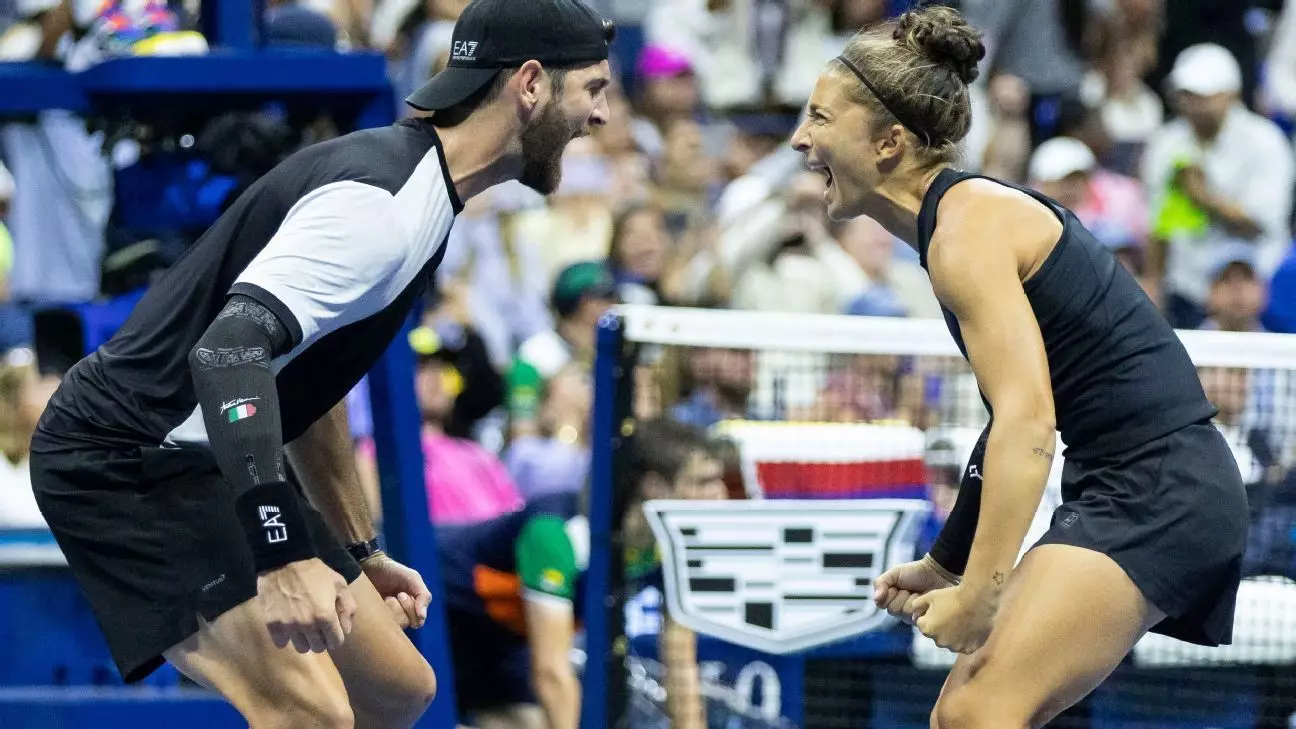In recent years, tennis has galloped toward a more spectacle-driven, high-stakes format that often sidelines the nuanced artistry of doubles. The US Open’s recent overhaul exemplifies this shift—prioritizing singles stars, condensed schedules, and innovative formats. Yet, amidst this upheaval, the story of Sara Errani and Andrea Vavassori emerges as a powerful testament to the enduring relevance and excitement that doubles can bring to the sport.
By radically restructuring the tournament—shortening match lengths, pre-dating the main singles event, and focusing on the allure of top singles competitors—the organizers aimed to inject fresh energy into the Grand Slam. However, critics argued that these changes risked diluting the integrity of doubles, traditionally regarded as a separate, specialized discipline within tennis. The victory of Errani and Vavassori challenges this narrative, emphasizing that great tennis is not limited to singles alone.
Their win symbolizes a broader message: that doubles, often overshadowed, retains a unique capacity to captivate audiences with its rapid exchanges, strategic finesse, and intense teamwork. The fact that a duo of specialists, hailing from Italy and seemingly outsiders in a format dominated by power players, could soar to victory underscores doubles’ resilience and its vital place in the sport’s ecosystem.
Underdogs and Undeniable Talent: Breaking Stereotypes
Errani and Vavassori’s journey was anything but predictable. Coming into the tournament with limited expectations and limited access to wild cards—especially for Errani, whose doubles prowess was well established—they showcased resilience and mastery driven by pure passion and skill. Their unassuming journey culminated in a stark reminder: tennis’s charm lies in its possibility for surprises, regardless of conventional rankings or marketability.
The duo’s ascent also shatters the misconception that doubles is a secondary category. Errani, a veteran with a decorated doubles career—including a career Grand Slam—used her experience to manipulate the court’s dynamics with intelligent net play and relentless defense. Vavassori’s height and athleticism added to their tactical arsenal, making it challenging for their opponents, including top singles stars Iga Swiatek and Casper Ruud, to contain their aggressive net approaches.
Their victory signifies that the best doubles teams aren’t simply those with big names or high singles rankings but are often the ones with superior chemistry, tactical understanding, and the willingness to embrace the craft. This win champions the idea that doubles is an intimate chess match in motion—an art form deserving of recognition and respect.
The Audience’s Role: Resurrecting Tennis’s Spectacle
What makes the Errani and Vavassori narrative particularly compelling is the audience’s unprecedented engagement. Despite criticism, the 2023 US Open’s restructured format succeeded in attracting filled stands, especially in Arthur Ashe Stadium—an arena traditionally reserved for the sport’s titans of singles. The packed crowd, the enthusiastic reactions, and the night’s electric atmosphere shattered expectations, affirming that tennis’s energy can thrive in unconventional formats.
This turn of events highlights an often-overlooked aspect: fans crave excitement, drama, and unpredictability. When top-tier players like Swiatek and Ruud battle fiercely, and when doubles teams demonstrate laser-sharp tactics, the sport appeals to a broader audience beyond the purists. Errani and Vavassori’s victory ignites a pivotal question: can innovative, crowd-centric formats revitalize not only interest but also the core spirit of tennis?
Their triumph suggests that reimagining traditional structures isn’t about diluting the sport but about expanding its narrative, making scalp-inspiring upsets, remarkable teamwork, and strategic brilliance accessible to new viewers. Tennis’s heartbeat remains in these dramatic moments—moments amplified when the audience is fully engaged and emotionally invested.
Challenging the Status Quo: Doubles’ Enduring Relevance
The success of Errani and Vavassori also serves as a subtle yet forceful critique of the sport’s current hierarchy, which often elevates singles stars at the expense of doubles specialists. Their win reflects a broader necessity: recognizing that tennis is richer and more dynamic when all facets, including doubles, are given platform and prominence.
Historically, doubles has suffered from a sense of relegation. Many talented players dedicate their entire careers to perfecting their craft, only to find their achievements overshadowed or marginalized. The Italian duo’s victory in a revamped, highly publicized tournament underscores a vital truth: doubles is not merely an appetizer to singles; it is an essential ingredient in the sport’s garnished plate.
Their triumph advocates for more equitable exposure, better reward structures, and innovative formats that celebrate doubles’ unique appeal. It’s an invitation for the tennis community—players, organizers, and fans alike—to embrace the sport’s full spectrum and to recognize that compelling narratives exist just as vividly in doubles as in singles.
The Power of Persistence and Passion
Errani and Vavassori’s story epitomizes perseverance. Their unlikely victory was rooted in years of dedication, tactical intelligence, and an unyielding love for the game. They chose to confront the skeptics and critics, demonstrating that genuine passion often triumphs over superficial expectations.
In a landscape that’s increasingly driven by media narratives and marketability, their win reaffirms the importance of authenticity. They represented not just their own ambitions but also those of the countless doubles players who rarely receive spotlight or applause. Their smiles and hugs after the match were not only signs of personal triumph but also gestures of defiance against a setup that once seemed stacked against them.
More than that, their victory highlighted a core truth: in tennis, it’s not always the biggest names or the highest seeds who claim victory, but those who bring heart, tact, and resilience to the court. They proved that passion combined with skill can shake up even

